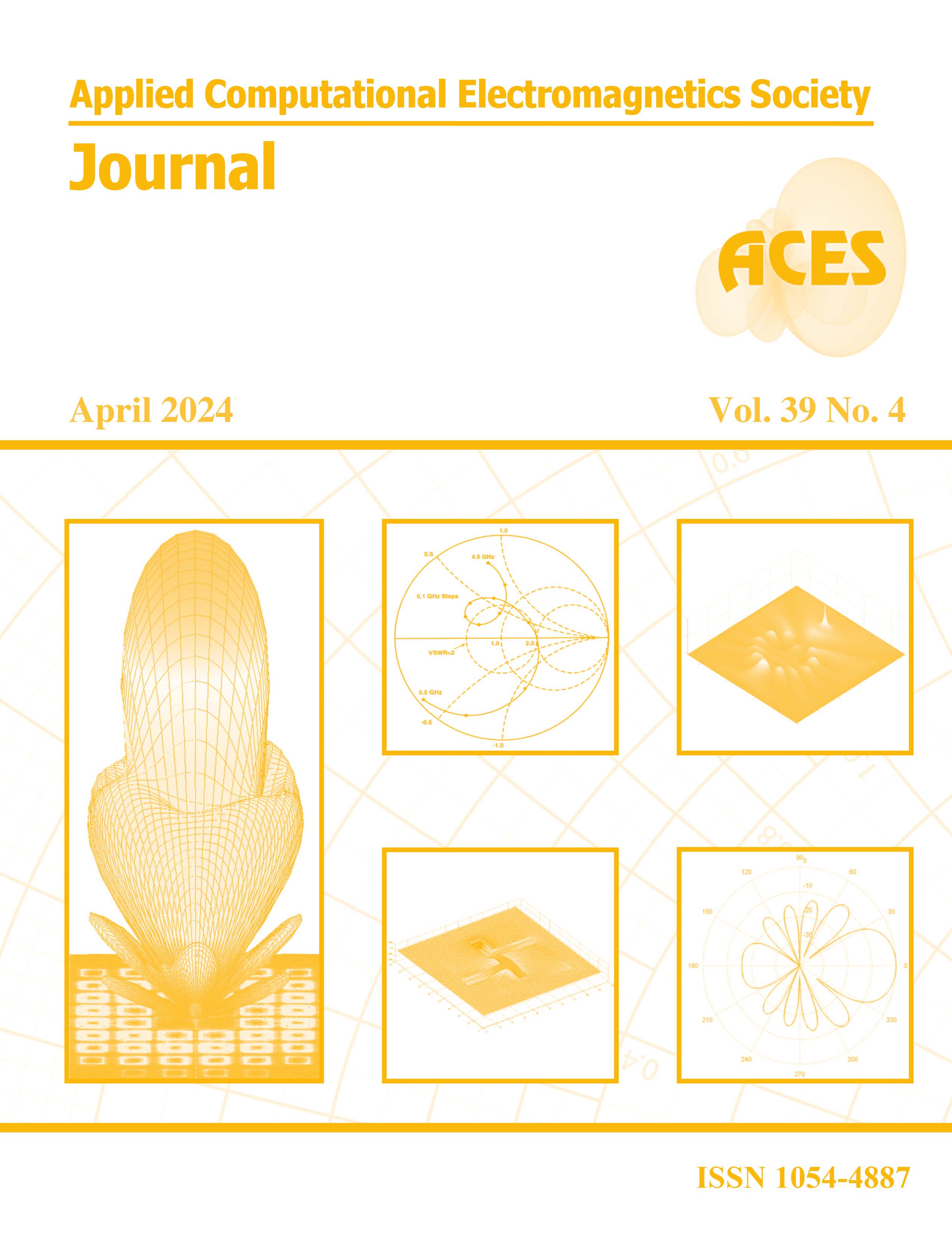Selective Microwave Wireless Power Transfer to Sensors Embeddedin Concrete at Sub-wavelength Spacing using ElectromagneticTime-reversal Technique
DOI:
https://doi.org/10.13052/2024.ACES.J.390410Keywords:
electromagnetic time reversal, sensors, super-resolution, wireless power transferAbstract
Wireless power transfer has become a trending research area for remotely transferring power. This paper presents the numerical simulation study of selective wireless power transfer to closely spaced wireless sensors embedded in reinforced concrete. A selective microwave wireless power transfer is achieved at a 10 mm separation between tightly-coupled monopole antennas (wireless sensor antennas). Both tightly-coupled wireless sensors operate at 2.45 GHz, hence beating the diffraction limit at λ/12 with the incorporation of additional scatterers in the reinforced concrete environment. The main objective is to realize selective wireless power transfer to wireless sensors with subwavelength separation (closely spaced) to which one makes the power request. Here, the presence of meta-structures creates some randomness serving as scatterers in the use of the electromagnetic time-reversal technique which enhances the spatial refocusing beyond the diffraction limit. This implies that the focal spot is less than half of the carrier wavelength at the operating frequency. At any time that one of the tightly-coupled sensor antennas sends a power request, power will be transferred to it alone. Cases of dry concrete with and without reinforced bars have been studied with electromagnetic time-reversal techniques for the closely spaced sensors embedded in concrete.
Downloads
References
R. H. Bhuiyan, M. R. Islam, J. M. Caicedo, and M. Ali, “A study of 13.5-MHz coupled-loop wireless power transfer under concrete and near metal,” IEEE Sens. J., vol. 18, no. 23, pp. 9848-9856,2018.
Y. Peng, W. Qi, Y. Chen, R. Mai, and U. K. Madawala, “Wireless sensor power supply based on eddy currents for structural health monitoring,” IEEE Trans. Ind. Electron., vol. 71, no. 7, pp. 1-10, 2023.
T. Bigler, G. Kovács, A. Treytl, and R. Windl, “NFC for powering sensors in concrete,” in IEEE Symposium on Emerging Technologies and Factory Automation, ETFA, pp. 1355-1358, 2020.
S. H. Lee, M. Y. Kim, B. S. Lee, and J. Lee, “Impact of rebar and concrete on power dissipation of wireless power transfer systems,” IEEE Trans. Ind. Electron., vol. 67, no. 1, pp. 276-287, 2020.
L. T. Tran, C. D. Khuat, and L. V. Phi, “A wideband, high gain and low sidelobe array antenna for modern ETC systems,” Applied Computational Electromagnetics (ACES) Journal, vol. 38, no. 5, pp. 333-342, 2023.
K. Kayalvizhi and S. Ramesh, “Design and analysis of reactive load dipole antenna using genetic algorithm optimization,” Applied Computational Electromagnetics (ACES) Journal, vol. 35, no. 3, pp. 279-287, 2020.
S. Syedyusuff, R. Subramaniam, and R. Vijay, “Orthogonally integrated hybrid antenna for intelligent transportation systems,” Applied Computational Electromagnetics (ACES) Journal, vol. 36, no. 5, pp. 519-525, 2021.
G. Castorina, L. Di Donato, A. F. Morabito, T. Isernia, and G. Sorbello, “Analysis and design of a concrete embedded antenna for wireless monitoring applications [antenna applications corner],” IEEE Antennas Propag. Mag., vol. 58, no. 6, pp. 76-93, 2016.
J. R. Tenório Filho, J. Goethals, R. Aminzadeh, Y. Abbas, D. E. V. Madrid, V. Cnudde, G. Vermeeren, D. Plets, and S. Matthys, “An automated wireless system for monitoring concrete structures based on embedded electrical resistivity sensors: Data transmission and effects on concrete properties,” Sensors, vol. 23, no. 21, p. 8775, 2023.
B. A. Twumasi and J. L. Li, “Numerical simulation study on bowtie antenna-based time reversal mirror for super-resolution target detection,” J. Electr. Eng., vol. 70, no. 3, pp. 236-243, 2019.
F. Cangialosi, T. Grover, P. Healey, T. Furman, A. Simon, and S. M. Anlage, “Time reversed electromagnetic wave propagation as a novel method of wireless power transfer,” in 2016 IEEE Wireless Power Transfer Conference, WPTC 2016, 2016.
S. Ding, S. Gupta, R. Zang, L. Zou, B. Z. Wang, and C. Caloz, “Enhancement of time-reversal subwavelength wireless transmission using pulse shaping,” IEEE Trans. Antennas Propag., vol. 63, no. 9, pp. 4169-4174, 2015.
M. Ku, Y. Han, H. Lai, Y. Chen, S. Member, and K. J. R. Liu, “Power waveforming: Wireless power transfer beyond time reversal,” IEEE Trans. Signal Processing, vol. 64, no. 22, pp. 5819-5834.
A. E. Fouda, F. L. Teixeira, and M. E. Yavuz, “Time-reversal techniques for MISO and MIMO wireless communication systems,” Radio Sci., vol. 47, no. 5, 2012.
G. Lerosey, J. De Rosny, A. Tourin, A. Derode, G. Montaldo, and M. Fink, “Time reversal of electromagnetic waves,” Physical Review Letters, vol. 92, no. 19, p. 193904.
O. W. Ata and M. I. Jawadeh, “Design of a novel split-bowtie slotted multi-resonant antenna,” International Journal of Electrical and Electronic Engineering & Telecommunications, pp. 1-8, 2022.
Y. Tawk, K. Y. Kabalan, A. El-Hajj, C. G. Christodoulou, and J. Costantine, “A simple multiband printed bowtie antenna,” IEEE Antennas Wirel. Propag. Lett., vol. 7, pp. 557-560, 2008.
P. Dhanaraj and S. Uma Maheswari, “Performance analysis of electrically coupled SRR bowtie antenna for wireless broadband communications,” Wireless Networks, vol. 26, no. 7, pp. 5271-5283, 2020.
H. Tu, S. Xiao, D. Lesselier, and M. Serhir, “Super-resolution characteristics based on time-reversed single-frequency electromagnetic wave,” J. Electromagn. Waves Appl., vol. 30, no. 13, pp. 1670-1680, 2016.




